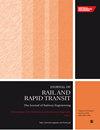用于铁路车辆辐射加热的电阻加热层压复合板的实际规模实验
IF 2.1
4区 工程技术
Q3 ENGINEERING, CIVIL
Proceedings of the Institution of Mechanical Engineers Part F-Journal of Rail and Rapid Transit
Pub Date : 2024-09-03
DOI:10.1177/09544097241279488
引用次数: 0
摘要
铁路作为具有代表性的大众运输系统之一,由于在人口稠密的环境中运行,很容易感染传染性极强的呼吸道疾病。值得注意的是,目前的对流供暖系统造成了铁路车辆内容易传播病毒的环境。为了改善这种状况,人们尝试引入辐射供暖系统,以降低病毒传播的风险,创造舒适的室内环境。以往的研究侧重于开发用于铁路车辆的辐射加热复合材料,在玻璃纤维复合材料中加入碳纤维加热元件,通过焦耳加热产生热量。然而,这种开发仅限于试样层面。相比之下,本研究旨在从部件层面证明其在实际轨道车辆部件中的适用性和性能。具体来说,我们分析了树脂流动性和可制造性,以评估对铁路车辆的适用性。此外,还对加热性能和热流特性进行了评估,以确定加热效果。基于这些结果,预计多功能复合材料在铁路行业的应用将改善对冬季病毒和室内环境的脆弱性,并扩大多功能复合材料在各个领域的应用。本文章由计算机程序翻译,如有差异,请以英文原文为准。
Real-scale experiments of resistive heating laminate composite panels for radiant heating in railway vehicles
Railways, as one of the representative mass transit systems, are vulnerable to highly contagious respiratory diseases due to their operation in densely populated environments. Notably, the current convective heating system creates an environment susceptible to virus transmission within railway vehicles. To improve this situation, there have been attempts to introduce radiant heating systems to reduce the risk of virus transmission and create a comfortable indoor environment. Previous studies focused on developing radiant heating composite material for railway vehicles by incorporating a carbon fiber heating element within a glass fiber composite to enable heat generation through joule heating. However, this development was limited to the specimen level. In contrast, this study aims to demonstrate their applicability and performance for actual railway vehicle parts at the component level. Specifically, resin flow and manufacturability were analyzed to assess applicability to railway vehicles. Additionally, heating performance and heat flow characteristics were evaluated to determine heating effects. Based on these results, it is anticipated that the application of multifunctional composite materials in the railway industry will improve the vulnerability to winter viruses and indoor environments and expand the utilization of multifunctional composite materials in various fields.
求助全文
通过发布文献求助,成功后即可免费获取论文全文。
去求助
来源期刊

CiteScore
4.80
自引率
10.00%
发文量
91
审稿时长
7 months
期刊介绍:
The Journal of Rail and Rapid Transit is devoted to engineering in its widest interpretation applicable to rail and rapid transit. The Journal aims to promote sharing of technical knowledge, ideas and experience between engineers and researchers working in the railway field.
 求助内容:
求助内容: 应助结果提醒方式:
应助结果提醒方式:


